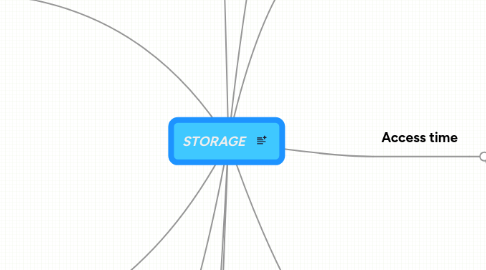
1. Hard Disks
1.1. storage data
1.1.1. perpendicular recording
1.1.2. longitudinal recording
1.2. characteristics
1.2.1. Sectors and Tracks
1.2.2. Capacity
1.2.3. Revolutions per Minute
1.2.4. Cylinders
1.2.5. Transfer Rate
1.2.6. Access Time
1.2.7. Platters
1.2.8. Read/Write Heads
1.3. Formatting
1.3.1. process that divine the disk into tracks or sectors
1.4. RAID(redundant array of independent disks)
1.4.1. a groups of two or more integrated dard disks
1.5. NAS(network attached storage)
1.5.1. a server connected to a network with the sole purpose of providing storage
1.6. external hard disk
1.6.1. free standing hard disk
1.7. removable hard disk
1.7.1. can insert and remove from a drive
2. Flash Memory Storage
2.1. SSDS(Solid state drives)
2.1.1. faster accessstie , generate less heat and consume less power,lastlonger
2.2. memory card
2.2.1. CompactFlash ( CF)
2.2.2. Secure Digital ( SD)
2.2.3. microSD
2.2.4. Secure Digital High Capacity (SDHC)
2.2.5. microSDHC
3. Flash Memory Storage
3.1. memory card
3.1.1. microSD
3.1.2. Memory Stick Micro (M2)
3.1.3. Secure Digital High Capacity (SDHC)
3.1.4. memory card
3.1.5. Secure Digital ( SD)
3.1.6. Memory Stick
3.1.7. xD Picture Card
3.1.8. microSDHC
3.2. USB flash drives
3.2.1. plug into a USB port on a computer or mobile device
3.3. ExpressCard module
3.3.1. a removable device that fits in an ExpressCard slot
3.3.2. Developed by the PCMCIA
3.3.3. Commonly used in notebook computers
3.4. Solid state drives (SSDs)
3.4.1. Faster access time,Generate less heat and consume less power
4. Cloud storage
4.1. an Internet service that provides storage to computer users
5. Optical Discs
5.1. Typically store software, data, digital photos, movies, and music
5.2. Read only vs. rewritable
5.3. VCD
5.3.1. CD‐RW
5.3.2. CD‐ROM
5.3.3. CD‐R
5.4. DVD
5.4.1. DVD‐ROM
5.4.2. DVD‐RW, DVD+RW, and DVD+RAM
6. Other Types of Storage
6.1. Tape
6.1.1. a magnetically coated ribbon of plastic capable of storing large amounts of data and information
6.2. magnetic stripe card
6.2.1. reading and writting data and information on a tape
6.3. micrefilm and micrpfiche
6.4. enterprise storage
6.5. smart cards
6.5.1. stores data on a thin microprocessor embedded in the card
7. Storage device
7.1. reading
7.1.1. transferring items from a storage medium into memory
7.1.2. from a storage medium into memory.
7.2. writing
7.2.1. transferring items from memory to a storage medium
7.2.2. from memory to a storage medium.
8. Access time
8.1. the amount of time to take a storage device to storage medium.
8.2. the time required to send an item from memory to the processor.
9. Access time
9.1. The amount of time it takes a storage device to locate an item on a storage medium
9.2. The time required to deliver an item from memory to the processor
10. Hard Disks
10.1. store data
10.1.1. longitudinal recording
10.1.2. perpendicular recording
10.2. Characteristics
10.2.1. Capacity
10.2.2. Platters
10.2.3. Read/Write Heads
10.2.4. Cylinders
10.2.5. Sectors and Tracks
10.2.6. Revolutions per Minute
10.2.7. Transfer Rate
10.2.8. Access Time
10.3. Formatting
10.3.1. the process of dividing the disk into tracks and sectors
10.4. RAID (redundant array of independent disks)
10.4.1. a group of two or more integrated hard disks
10.5. A network attached storage (NAS)
10.6. external hard disk
10.6.1. frees tanding hard disk
10.7. removable hard disk
10.7.1. can insert and remove from a drive
